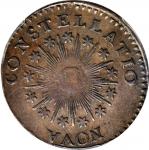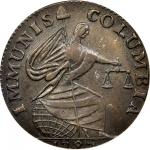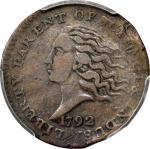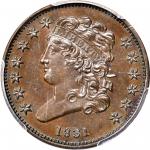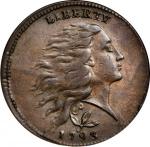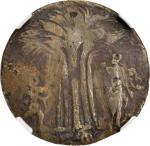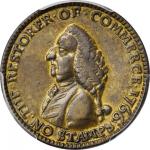64.2 grains. A remarkably well produced and preserved example of this rarer Pitt token type. The strike is well centered with full denticulation around both sides. Bold to sharp detail is also noted for most of the devices; only the central hair detail and the portholes on the reverse ship are somewhat indistinct. Indeed, this is one of the sharpest Pitt farthings that we can ever recall handling. Much of the natural golden-brass color remains, there being only minimal mellowing to light brown. A few insignificant pits and handling marks in the fields require magnification to discern, and they are certainly easily overlooked. Generally smooth, this is one of the finest examples of the type that we have ever offered.The French and Indian Wars of the 1750s took a huge toll on British finances, compelling Parliament to find new and creative ways to generate revenue to counteract the expenses incurred. One such proposal came to fruition in March 1765 with the passage of the Stamp Act, imposing tariffs on paper intended for use in the colonies and requiring the use of an embossed stamp. The colonists had no say in the law and vehemently opposed it from the beginning. The colonists found an ally in William Pitt, who worked diligently against the Act, finally succeeding in its repeal on March 11, 1766. The controversies surrounding the Stamp Acts passage and eventual revocation gave birth to the concept and expression of "no taxation without representation," a phrase that remains in common parlance, in particular on the current license plates for the District of Columbia. <br /><br />Precisely who authorized and struck the 1766 Pitt farthing and halfpenny tokens is not known. The traditional attribution for the pieces is based on the observations of by Montroville Dickeson in 1859 claiming that Philadelphia gunsmith and engraver James Smither produced them at the request of "The Friends of Liberty and Trade." Struck in two sizes, a farthing size, as here, and a halfpenny size, both bear the inscription THE RESTORER OF COMMERCE 1766 and NO STAMPS surrounding a bust of Pitt on the obverse, and on the reverse a ship at full sail, AMERICA in front of the ships bow, all surrounded by THANKS TO THE FRIENDS OF LIBERTY AND TRADE. Given the nature of the inscriptions and the quality of workmanship, it is very possible that the pieces were struck in England at the behest of the merchant groups who supported Pitt. While usually called halfpennies and farthings, the weights fall far below Royal standard, were not proportional to each other and were likely not intended as such. Despite this, most known specimens are found heavily worn and likely saw some circulation at a time when coppers of any sort were in high demand. A few examples have been recovered by metal detectorists in America but it remains unknown if there were any large importations of the pieces. <br /><br />The farthing token is far and away rarer than its larger sibling and is missing in even the notable collections of colonial coins and related tokens. The offered piece is by far the finest known of the Betts-520 Pitt farthings and is tied with a "silvered" brass farthing; the next highest examples on the Condition Census are AU pieces noted with environmental damage. With its prominent provenance and at the pinnacle for the series, this piece will be coveted by advanced specialists in pre-Revolutionary token coinages.,,PCGS# 232. NGC ID: 2AYM.,PCGS Population: just 1; 0 finer.,From our (Stacks) sale of the John L. Roper, 2nd Collection of Colonial & Early American Coins, December 1983, lot 169.


